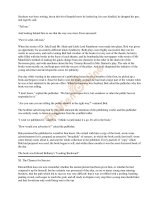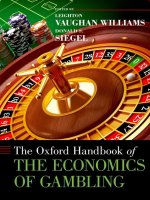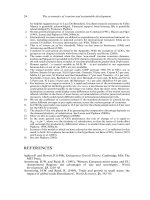The economics of sports ed 6
Bạn đang xem bản rút gọn của tài liệu. Xem và tải ngay bản đầy đủ của tài liệu tại đây (8.18 MB, 777 trang )
The Economics of Sports
The sports industry provides a seemingly endless set of examples from every
area of microeconomics, giving students the opportunity to study economics
in a context that holds their interest. Thoroughly updated to reflect the
current sports landscape, The Economics of Sports introduces core economic
concepts and theories and applies them to American and international sports.
Updates for this sixth edition include:
More coverage of international sports, including European football;
A revised chapter on competitive balance, reflecting new techniques;
A brand-new chapter on mega-events such as the Olympics and World
Cup;
New material on umpire bias;
A completely redesigned chapter on amateur competition that focuses
exclusively on intercollegiate sports. This chapter is also now modular,
enabling instructors who wish to intersperse it with the other chapters
to do so with greater ease.
This accessible text is accompanied by a companion website which includes
resources for students and instructors. It is the perfect text for advanced
undergraduate and graduate courses on sports economics.
Michael A. Leeds is Professor and Department Chair of Economics at Temple
University, Philadelphia, PA, USA, and a research associate at IZA, USA. He
has published numerous articles in labor economics and the economics of
sports, and was co-editor of the Handbook on the Economics of Women in
Sports. He has won departmental, college, and university awards for his
teaching. From 2007 to 2009, he was an Assistant Dean at Temple University,
Japan.
Peter von Allmen is Professor at the Department of Economics, Skidmore
College, Saratoga Springs, NY, USA. He previously served as the president of
the North American Association of Sports Economics, and his primary
research area is sports economics, with a particular focus on compensation
schemes, incentives, and monopsony power.
Victor A. Matheson is Professor of Economics at the College of the Holy
Cross, Worcester, MA, USA. He is co-editor of the Journal of Sports
Economics and has written over 80 journal articles and book chapters. In
addition, he worked as a soccer referee for 30 years and has officiated matches
in Major League Soccer as well as over 400 Division 1 college games.
The Economics of Sports
Sixth Edition
Michael A. Leeds, Peter von Allmen and Victor A. Matheson
Sixth edition published 2018
by Routledge
711 Third Avenue, New York, NY 10017
and by Routledge
2 Park Square, Milton Park, Abingdon, Oxon, OX14 4RN
Routledge is an imprint of the Taylor & Francis Group, an informa business
© 2018 Taylor & Francis
The right of Michael A. Leeds, Peter von Allmen and Victor A. Matheson to be identified as authors of
this work has been asserted by them in accordance with sections 77 and 78 of the Copyright, Designs
and Patents Act 1988.
All rights reserved. No part of this book may be reprinted or reproduced or utilised in any form or by
any electronic, mechanical, or other means, now known or hereafter invented, including photocopying
and recording, or in any information storage or retrieval system, without permission in writing from the
publishers.
Trademark notice: Product or corporate names may be trademarks or registered trademarks, and are
used only for identification and explanation without intent to infringe.
First edition published by Pearson Education 2001
Fifth edition published by Pearson 2014
Library of Congress Cataloging-in-Publication Data
A catalog record for this book has been requested
ISBN: 978-1-138-05216-1 (hbk)
ISBN: 978-1-315-16794-7 (ebk)
Typeset in Corbel and Myriad Pro
by Apex CoVantage, LLC
Visit the companion website: www.routledge.com/cw/Leeds
Brief Contents
List of Figures
List of Tables
Preface
Part One: Introduction and Review of Economic Concepts
1 Economics and Sports
2 Review of the Economist’s Arsenal
Part Two: The Industrial Organization of Sports
3 Sports Leagues and Franchises
4 Monopoly and Antitrust
5 Competitive Balance
Part Three: Public Finance and Sports
6 The Public Finance of Sports: Who Benefits and How?
7 The Public Finance of Sports: Who Pays and Why?
8 Mega-Events
Part Four: The Labor Economics of Sports
9 An Introduction to Labor Markets in Professional Sports
10 Labor Market Imperfections
11 Discrimination
Part Five: Sports in the Not-for-Profit Sector
12 The Economics of Intercollegiate Sports
References
Index
Detailed Contents
List of Figures
List of Tables
Preface
Part One: Introduction and Review of Economic Concepts
1 Economics and Sports
Introduction
1.1 The Organization of the Text
Special Features and Additional Resources
1.2 Babe Ruth and Comparative Advantage
Opportunity Costs
Absolute and Comparative Advantage
Biographical Sketch: Babe Didrikson Zaharias
Summary, Discussion Questions, Problems
2 Review of the Economist’s Arsenal
Introduction
Learning Objectives
2.1 The Supply and Demand Model
Demand, Supply, and Equilibrium
Changes in Supply and Demand
2.2 Output and the Production Function
A Note on the Definition of Output
The Production Function
Price Ceilings and the Economics of Scalping
2.3 Market Structures: From Perfect Competition to Monopoly
Perfect Competition
Monopoly and Other Imperfectly Competitive Market Structures
The Impact of an Increase in Costs
2.4 The Rise of Professional Sports
Biographical Sketch: Mark Cuban
Summary, Discussion Questions, Problems
Appendix 2A: Utility Functions, Indifference Curves, and Budget
Constraints
2A.1 Constrained Maximization
2A.2 Using Indifference Curves and Budget Constraints: The Rise of Soccer
and Baseball
Appendix 2B: Regression Analysis in Brief
Part Two: The Industrial Organization of Sports
3 Sports Leagues and Franchises
Introduction
Learning Objectives
3.1 Open versus Closed Leagues
3.2 The Economics of Team Behavior
Maximizing Profits or Maximizing Wins?
3.3 Closed Leagues: Revenue and Cost in North American Sports
Revenue and Cost
Revenue Is Determined by Demand
A Detailed Look at Revenue
Costs
League Size, Opportunity Cost, and Team Movement
3.4 Open Leagues: Revenue and Cost in European Soccer
Profit Maximization in Soccer
3.5 Single-Entity Ownership
Biographical Sketch: Bill Veeck
Summary, Discussion Questions, Problems
4 Monopoly and Antitrust
Introduction
Learning Objectives
4.1 What’s Wrong with Monopoly?
Monopolists and Deadweight Loss
Do Monopolies Always Charge Monopoly Prices?
Promotion, Relegation, and Monopoly Power in Open Leagues
4.2 Strategic Pricing
Variable and Dynamic Ticket Pricing
Bundling
Price Discrimination and Two-Part Pricing
4.3 What’s Right with Monopoly?
4.4 Strategic Barriers to Entry
4.5 Society’s Response to Monopoly: Antitrust Laws
An Important Anomaly: Baseball’s Antitrust Exemption
Leagues That Lack an Antitrust Exemption
Limited Exemptions: The NFL and Television
Biographical Sketch: Alvin “Pete” Rozelle
Summary, Discussion Questions, Problems
5 Competitive Balance
Introduction
Learning Objectives
5.1 Why Study Competitive Balance?
The Fans’ Perspective
The Owners’ Perspective
The Effect of Market Size
The Influence of Diminishing Returns
A Brief History of Competitive Balance
5.2 Measuring Competitive Balance
Within-Season Variation
Between-Season Variation
Illustrating Competitive Imbalance
5.3 Attempts to Alter Competitive Balance
The Invariance Principle
Revenue Sharing
Salary Caps and Luxury Taxes
The Reverse-Order Entry Draft
Schedule Adjustments in the NFL
Promotion and Relegation
Biographical Sketch: Bud Selig
Summary, Discussion Questions, Problems
Part Three: Public Finance and Sports
6 The Public Finance of Sports: Who Benefits and How?
Introduction
Learning Objectives
6.1 How Teams Benefit from New Facilities
Facilities, Attendance, and Profits
6.2 How Fans Benefit from a New Facility
The Size and Shape of Stadiums and Arenas
The Size and Shape of Basketball and Hockey Arenas
The Size and Shape of Football and Soccer Stadiums
Do New Facilities Create Better Teams?
Teams as Public Goods
6.3 How Cities Benefit from Teams and Facilities
Positive and Negative Externalities
Facilities, Spending, and Tax Revenue
Studies of Economic Impact
Interest Groups and Public Choice
Location, Location, Location
Biographical Sketch: Al Davis
Summary, Discussion Questions, Problems
7 The Public Finance of Sports: Who Pays and Why?
Introduction
Learning Objectives
7.1 How Cities Came to Fund Stadiums
Teams on the Move
The Four Eras of Stadium Construction
7.2 How Teams Exploit Monopoly Power
Leagues, Cities, and Market Power
7.3 Stadium Location and Costs
How Exchange Rates Affect Costs
Why Most Stadiums Are Not in the Center of Town
7.4 Stadium Costs and Financing
7.5 Paying for Stadiums
Who Pays a Sales Tax?
Incremental Financing
Taxes That Spread the Burden
The Benefits of Debt
Biographical Sketch: George W. Bush
Summary, Discussion Questions, Problems
8 Mega-Events
Introduction
Learning Objectives
8.1 A Brief History of Mega-Events
The Original Mega-Event: The Ancient Olympics
The British Ethic and the Rise of the Modern Olympics
The Modern Olympic Games
FIFA and the World Cup
8.2 The Short-Run Benefits of Hosting Mega-Events
Two Types of Event Studies
Problems with ex ante Economic Impact Studies
Ex post Economic Impact Studies
8.3 The Long-Run Benefits of Hosting Mega-Events
General Infrastructure
Advertising and Branding
8.4 The Costs of Hosting Mega-Events
8.5 Why Do Cities Continue to Bid?
Distribution of Costs and Benefits
Non-Economic Rationales
The Winner’s Curse
The All-or-Nothing Demand Curve
Biographical Sketch: Willard “Mitt” Romney
Summary, Discussion Questions, Problems
Part Four: The Labor Economics of Sports
9 An Introduction to Labor Markets in Professional Sports
Introduction
Learning Objectives
9.1 An Overview of Labor Supply and Labor Demand
Labor Supply
Labor Demand
Labor Market Equilibrium
Human Capital and Player Compensation
9.2 Rank-Order Tournaments and Superstar Effects
Tournaments and Effort
Women and Tournaments
The Economics of Superstars
Tournaments, Superstars, and the Distribution of Income
9.3 The Dangers of Tournaments and Superstar Effects
Pay Disparities and Externalities: The Case of NASCAR
The Danger of Trying Too Hard
Performance-Enhancing Drugs
Biographical Sketch: Scott Boras
Summary, Discussion Questions, Problems
Appendix 9A: Using Indifference Curves to Model the Labor–Leisure
Choice
9A.1 The Labor–Leisure Model When Hours Are Fixed
10 Labor Market Imperfections
Introduction
Learning Objectives
10.1 The Monopsony Power of Sports Leagues
The Economics of Monopsony
The Impact of Rival Leagues
The Reserve Clause
10.2 Unions in Professional Sports
A Brief Introduction to the Economics of Unions
The Unique Role of Player Associations
Professional Associations
10.3 Free Agency
The Advent of Free Agency
Forms of Free Agency
The Franchise Tag
Salary Arbitration
Measuring Monopsony Power
Salary Caps
Luxury or Competitive Balance Taxes
10.4 Conflict and Compromise in Collective Bargaining
Economic Theory and Labor Conflict
Labor Conflict and Professional Sports
Biographical Sketch: Marvin Miller
Summary, Discussion Questions, Problems
11 Discrimination
Introduction
Learning Objectives
11.1 Evidence of Discrimination in Sports
11.2 The Economic Theory of Discrimination
11.3 Different Forms of Discrimination in Professional Sports
Employer Discrimination
Does Anyone Win with Employer Discrimination?
Employee Discrimination
Consumer Discrimination
Positional Discrimination or Hiring Discrimination
11.4 Gender Equity
What Is a Woman?
Biographical Sketch: Branch Rickey
Summary, Discussion Questions, Problems
Part Five: Sports in the Not-for-Profit Sector
12 The Economics of Intercollegiate Sports
Introduction
Learning Objectives
12.1 The NCAA
A Brief History of the NCAA
The Structure of the NCAA
12.2 The Costs and Benefits of Big-Time College Sports
The Revenue from Intercollegiate Athletics
The Cost of Intercollegiate Athletics
Do Colleges Make a Profit from Athletics?
12.3 Monopoly Power in College Athletics
The NCAA and Optimal Cartel Behavior
Prisoner’s Dilemma: How Rational Actions Lead to Irrational Outcomes
Academic Standards: A Key to Academic Integrity or Exercise of
Monopoly Power?
Antitrust and College Sports
12.4 Spillovers from Athletics to the University
College Sports as Public Goods
Admissions
Donations and State Funding
12.5 The College Sports Labor Market
The Value of Athletes to Colleges
The Value of College to Athletes
12.6 Discrimination and College Sports
Racial Discrimination
Title IX and Gender Discrimination
Biographical Sketch: Sonny Vaccaro
Summary, Discussion Questions, Problems
References
Index
Figures
2.1 The Demand for Baseball Cards
2.2 The Supply of Baseball Cards
2.3 Equilibrium in the Baseball Card Market
2.4 Changes in the Demand for and Supply of Baseball Cards
2.5 A Change in Supply Due to a Tax
2.6 Relatively Elastic versus Inelastic Supply
2.7 The Supply of Mickey Mantle and Hank Aaron Cards
2.8 The Relationship between Individual Demand and Market Demand for
Baseball Cards
2.9 Differences in Demand for Hank Aaron and Mickey Mantle Cards Create
Differences in Price
2.10 (a) The Total Product Curve, (b) the Marginal Product Curve, and (c) the
Marginal Cost Curve
2.11 The Effect of a Price Ceiling
2.12 Determination of Competitive Firm Demand
2.13 Marginal Revenue and Marginal Cost
2.14 Demand and Marginal Revenue from Ticket Sales
2.15 Rockies Attendance and Prices
2.16 (a) Blackhawks Attendance and Prices, (b) White Sox Attendance and
Prices
2.17 A Change in Demand Due to the Addition of a Marquee Player
2.18 The Marginal Utility and Marginal Cost of Leisure Time
2A.1 Consumer Preferences
2A.2 Indifference Curves
2A.3 Diminishing Marginal Rate of Substitution
2A.4 The Impossibility of Intersecting Indifference Curves
2A.5 Budget Constraint
2A.6 The Effect of Changes in Price on the Budget Constraint
2A.7 The Effect of an Increase in Income
2A.8 The Utility-Maximizing Bundle
2A.9 The Trade-Off between Goods and Leisure
2A.10 The Utility-Maximizing Combination of Goods and Leisure
2A.11 Subsistence Level of Income Allows No Leisure
2A.12 An Increase in Income Allows for Some Leisure
2B.1 Scatterplot of Attendance and Winning Percentage in MLB, 2016
2B.2 The Regression Line
3.1a Total Revenue and Total Cost Curves
3.1b Profit-Maximizing and Win-Maximizing Behavior
3.2 Revenue, Cost, and City Size
3.3 Gate Revenue for the NBA, NFL, NHL, and MLB
3.4 Determining the Optimal Size of a Closed League
3.5 The Effect of Entry on Demand
4.1 The Cost of a Monopoly to Society
4.2 Consumer Surplus for Individual Consumers
4.3 Variable Ticket Pricing
4.4 Segmented Market Price Discrimination
4.5 Representative Demand Curve for a Consumer and Two-Part Pricing
4.6 Profit-Maximizing Output for a Natural Monopoly
5.1 The Benefit of Improving the Team Depends on Market Size
5.2 The Lorenz Curves for La Liga and the NHL, 2015–2016
5.3 The Market for Tickets to the Opening Ceremonies at the 2018 Olympics
6.1 Seating and Field Configuration for a “Cookie-Cutter” Stadium
6.2 Seating and Field Configuration for a Football-Only Stadium
6.3 Seating and Field Configuration for a Modern Baseball-Only Stadium
6.4 A New Facility Might Encourage a Team to Win More Games
6.5 Negative Externalities Shift the Supply Curve Leftward
6.6 Positive Consumption Externalities Shift the Demand Curve Outward
7.1 The Currency Market Sets the Exchange Rate for Canadian and US Dollars
7.2 Competing Firms Move to the Center of Town
7.3 The Rent Gradient
7.4 The Impact of a $4/Night Tax on Hotel Stays
7.5 A Tax on Dialysis Causes Very Little Deadweight Loss
7.6 Tax Breaks Favor Municipal Bonds
8.1 Athens’ Olympic Athletic Center, the “Spiros Louis” Stadium, Built in 2004
and Fallen into Disrepair Less Than Ten years Later
8.2 A Monopolist Can Extract Consumer Surplus by Setting Price and
Quantity
9.1 Average Player Salaries in the Major Leagues Since 1991
9.2 Individual and Market Labor Supply Curves for Workers and Boxers
9.3 The Labor Demand Curve
9.4 The Equilibrium Wage and Quantity in the Labor Market
9.5 Wages Increase in the NBA Due to Increases in Demand
9.6 The Effect of Roster Limits
9.7 The Increasing Marginal Cost of Effort
9.8 Creating the Incentive for a High Level of Effort in a Tournament
9.9 Minor Differences in Performance Can Lead to Large Shifts in Demand
9.10 The Lorenz Curve for the ATP’s Top 50 Money Winners in 2016
9.11 Comparing the Rewards in the 2015 PGA Championship and the 2015
Daytona 500
9.12 PED Use: A Prisoner’s Dilemma
9A.1 Indifference Curves
9A.2 The Income and Time Constraints
9A.3 Individual Utility-Maximizing Curves
9A.4 Changes in Labor Supply Due to Wage Changes
9A.5 The Individual Labor Supply Curve
9A.6 Increases in Wealth That Result in No Labor Supplied
9A.7 Labor Supply When Players Cannot Choose the Number of Games
10.1 Employment and Wage Level for a Monopsonist
10.2 Effect of Unions on Wages
10.3 Bilateral Monopoly
10.4 Payrolls for Teams in the Four Major Leagues
10.5 The Contract Zone
10.6 (a) Contract Zone with Powerful Union, (b) Contract Zone with Powerful
Employer, (c) Mistaken Perceptions about the Contract Zone
11.1 (a) Equilibrium Wages with Discrimination; (b) Equilibrium Wages with
No Discrimination
11.2 Discrimination with a Large Pool of Players
11.3 The Color Line Breaks Down as a Result of the Prisoner’s Dilemma
12.1 Cartels and Marginal Cost
12.2 Optimal Division of Output by a Cartel
Tables
1.1 The Gain and Loss from Moving Babe Ruth
2.1 Career Statistics of Hank Aaron and Mickey Mantle
2B.1 Multiple regression results
3.1 Performance Measures for the Phillies, Yankees, Indians, and Royals, 2011–
2016
3.2 Dallas Mavericks’ and Toronto Raptors’ winning percentage and operating
income, 2007–2012
3.3 Market Value, Revenue, Payroll, Gate Revenue, and Operating Income,
2016
3.4 Current US Major League Television Broadcasting Deals
3.5 The Ten Most Lucrative US Naming Rights Deals (in $ Millions)
3.6 Ten Most Populous Metropolitan Statistical Areas and Their Sports Teams,
2017
3.7 Top Ten European Soccer Club Values and Revenues, 2016
3.8 Organizational Structure of English Soccer
3.9 The Hierarchy of English Soccer Competition
3.10 Revenue Distributions for the EPL, the Bundesliga, La Liga, Serie A, and
Ligue1, 2014–2015
4.1 Changes in Attendance and Average Ticket Prices 2001–2016
5.1 New York Yankees’ Success and American League and National League
Attendance, 1950–1958
5.2 Winning Percentages for the National and American Leagues, 1996
5.3 Dispersion of Winning Percentages, 2015–2016
5.4 Distribution of Championships, 2006–2007 to 2015–2016
6.1 Stadium Age and Luxury Seating for the Five Most Valuable NFL
Franchises
6.2 MLS Soccer-Specific Stadiums
6.3 How Logrolling Can Improve Social Well-Being
7.1 Stadium Construction in North American Sports Leagues, 1990–2017
7.2 Facilities Built between 2010 and 2017
8.1 Number of Bids for Summer and Winter Olympic Games
8.2 Direct Revenues from Olympic Games
8.3 Examples of Mega-Event ex ante Economic Impact Studies
8.4 Examples of Mega-Event ex post Economic Impact Studies
8.5 Costs of Hosting Mega-Events
9.1 The Five Highest-Paid Celebrities and Athletes in the Forbes 2016
“Celebrity 100”
10.1 Labor Unrest in Professional Sports Since 1980
11.1 Racial and Ethnic Breakdown of MLB Players in 2015 at Selected
Positions (%)
11.2 Percentage of Whites at Different Levels of Professional Sports Leagues
(%)
11.3 Performance and Rewards for Men’s and Women’s Soccer Teams
12.1 Market Value and Revenue for the 20 Most Valuable Football Programs
12.2 Power 5 Conference Broadcast Revenue for Football
12.3 Selected Bowl Payouts in 2016–2017
12.4 Bowl Payouts by Conference
12.5 Mean Revenues, Expenditures, Subsidies, and Profits for FBS Athletic
Departments
12.6 College Football Broadcasts as a Prisoner’s Dilemma
12.7 Graduation Success Rates (GSRs) for Men’s 2015 Sweet 16 Teams
12.8 Graduation Success Rates (GSRs) for Women’s 2015 Sweet 16 Teams
12.9 The Probability of Signing with a Professional Team
Preface
As always seems to be the case, much has happened in the world of sports
since the publication of the previous edition. From the doping scandals that
rocked the most recent Olympics to the movement of not one but two NFL
franchises to Los Angeles and the $200 million NCAA settlement over the cost
of attendance, the economic landscape of professional and amateur sports is
constantly changing. As a reflection of the dynamic nature of the field, the
sixth edition of The Economics of Sports includes several major changes since
the fifth edition.
Perhaps the most notable change is the addition of Victor A. Matheson from
the College of the Holy Cross to the author team. Victor is an internationally
recognized expert in the field of sports economics, most notably in the
economic impact of franchises and mega-events. A second major change for
this edition is a direct result of Victor’s influence on the book: the addition of
a new chapter devoted to mega-events, such as the World Cup and the
Olympics. Separating mega-events from the analysis of franchise location and
the costs and benefits of stadium funding allows us to analyze the public
finance of sport more clearly and completely.
In addition to adding a new author, we have a new publisher. We are very
excited to join Taylor & Francis. From our first meeting, we were impressed
with their ability to see our vision for a comprehensive approach to learning
sports economics that includes not only the text but also a full complement of
online resources, including an author blog, mini-lectures from the authors,
and enhanced lecture support materials and instructor resources.
From its modest beginnings as something of a novelty, sports economics has
become a vibrant sub-discipline within the larger field of applied
microeconomics, fully recognized by the American Economic Association as a
stand-alone field with its own JEL classification code. Researchers tend to be
drawn to the field for two reasons: the wide variety of interesting economic
questions one can ask about the industry itself and the extraordinary
availability of data that allow economists to use sport to answer broader
questions about economic relationships.
As the research field has developed, the number of sports economics courses
has grown as well. Throughout this growth and change, sports economics
continues to serve as both a mirror and a lens; reflecting our broader culture
and values, while bringing into focus such fundamental issues as fairness and
the legitimacy of free markets. With the passing of each season, new events
unfold in professional and amateur sports that call out for analysis. Finally, in
the context of this book, sports economics remains a vital and interesting area
of study for students of economics. Sports provides a seemingly endless set of
examples from every area of microeconomics, giving students the opportunity
to study public finance, industrial organization, and labor markets in a context
that holds student interest like no other.
Over the many years that we have worked on this project, we have enjoyed
continuous help and support from students and colleagues at colleges and
universities across the United States and around the world. Our colleagues
continue to offer encouragement, share classroom experiences, and suggest
new and different coverage as the industry evolves. For all this support and
help, we are most grateful. We hope that our own enthusiasm, as well as the
enthusiasm others have shared with us, is reflected in the text.
New to This Edition
The sixth edition contains several meaningful changes that are reflected
throughout the book. These changes enhance the features from previous
editions that have made learning about sports economics meaningful as well
as enjoyable:
We have added significant coverage of sports outside North America,
most notably, European soccer. While you will find discussion of
leagues and events outside North America throughout the text, this
new material is most evident in Chapters 3, 4, and 8.
As noted above, Chapter 8 is new to the book. This chapter covers the
economics of mega-events such as the Olympics, the World Cup, and
the Super Bowl.
Because we now devote significant attention to the Olympics in the
chapter on mega-events, Chapter 12 now deals solely with
intercollegiate sports in the US.
The material on intercollegiate sports in Chapter 12 has been
significantly modified to reflect the different ways in which people
teach this material. Those who wish to treat intercollegiate sports
separately from professional sports may continue to use Chapter 12 as
a stand-alone chapter. However, the material in Chapter 12 now
parallels the coverage of the preceding chapters. This allows
instructors who wish to use intercollegiate sports to illustrate earlier
concepts to “cut and paste” these sections into earlier chapters.
We have added significant discussion of empirical findings of
economists throughout the text.
All tables and figures have been updated to reflect the most recently
available information.
We have substantially increased the volume and types of online









